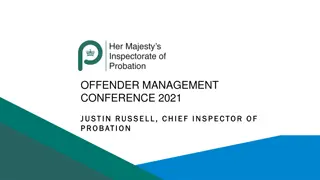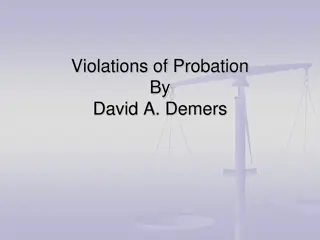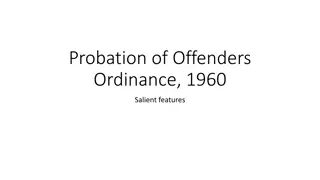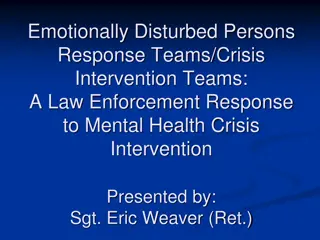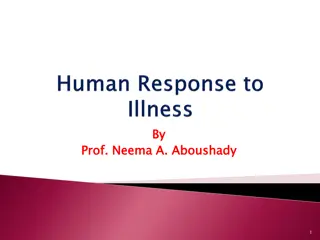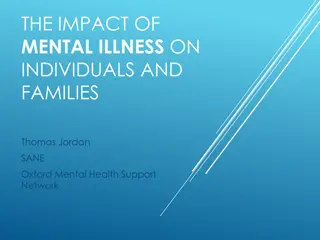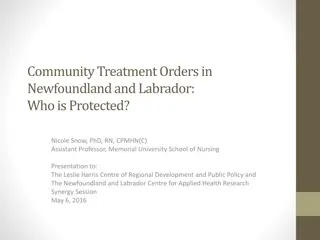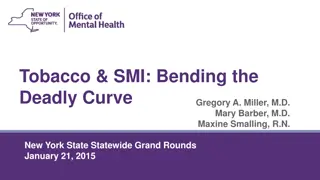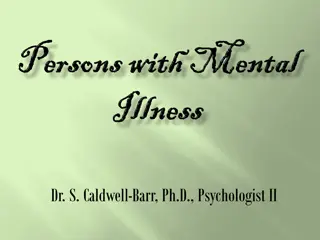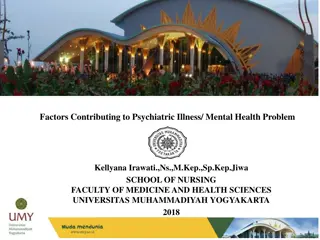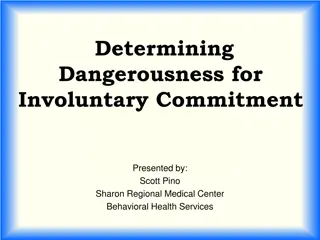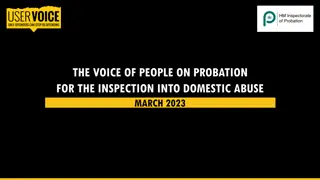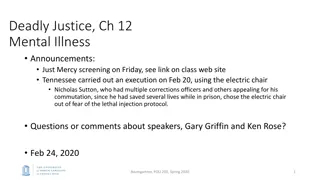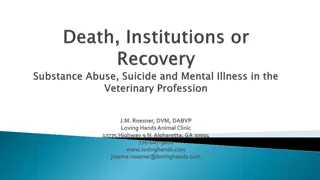Understanding Mental Illness among People on Probation
Explore the prevalence of mental illnesses among individuals on probation, the challenges in supervising them, various approaches to address mental health issues, policy implications, and key study findings. Acknowledgments to state and local probation agencies for their involvement and funding from the Pew Charitable Trusts. Referenced studies include the National Survey on Probation and Mental Health, National Survey of Drug Use and Health, and Survey of Prison Inmates.
Download Presentation

Please find below an Image/Link to download the presentation.
The content on the website is provided AS IS for your information and personal use only. It may not be sold, licensed, or shared on other websites without obtaining consent from the author. Download presentation by click this link. If you encounter any issues during the download, it is possible that the publisher has removed the file from their server.
E N D
Presentation Transcript
Tonya VanDeinse, University of North Carolina at Chapel Hill Veronica Cunningham, American Probation and Parole Association Tracy Vel zquez, Pew Charitable Trusts August 2022 National Association of Sentencing Commissions
PRESENTATION OVERVIEW Introductions Prevalence of mental illnesses among people on probation Challenges of supervising people with mental illnesses on probation Approaches to addressing mental illness among people on probation Policy implications Q&A
ACKNOWLEDGEMENTS The team would like to thank state and local probation agencies for their participation in the study. Funding for the National Survey of Probation and Mental Health was provided by the Pew Charitable Trusts
INFORMATION SOURCES Throughout the session, we will reference findings from three studies: The National Survey on Probation and Mental Health (NSPMH) UNC Chapel Hill, American Probation and Parole Association, Pew Charitable Trusts Sample: Randomly selected 315 counties from across the country; 179 counties responded, representing 43 states National Survey of Drug Use and Health (2017-2019) (NSDUH) SAMSHA survey of 70,000 people aged 12+ (only adult data used), weighted to be nationally representative Survey of Prison Inmates (2016) (SPI) BJS survey of 20,000 people in state prison, weighted to provide national estimates
PREVALENCE OF MENTAL ILLNESS
How Is Prevalence Determined? Prior studies: Accurate estimates are difficult to obtain How is mental illness defined? What instrument is being used? Who is included in the sample? Does the agency track the information? Who is providing the information? Bureau of Justice Statistics, 1999 report 16% of people on probation identified as having a mental health condition Mental health condition defined as: having a mental or emotional condition or a history of psychiatric hospitalization (at least one overnight stay) Crilly et al., 2009: 27% based on the 2001 National Household Survey on Drug Abuse Van Deinse et al., 2019: 15%-19% based on statewide administrative data
PREVALENCE ESTIMATES FROM THE NATIONAL SURVEY OF PROBATION AND MENTAL HEALTH Respondents (probation personnel) were asked to provide the percentage of people on probation in their county who had a mental illness (defined broadly) For the purposes of this study, the term mental illness refers to either: 1) a mental illness, such as schizophrenia, bipolar disorder, depression, generalized anxiety disorder and/or post-traumatic stress disorder (PTSD), that has been diagnosed by a medical or mental health provider; 2) individual self-report of a diagnosis from a medical or mental health provider; or 3) a potentially undiagnosed mental illness that has been flagged using screening or assessment instruments that may be part of a probation department s documentation or intake process. Although substance use disorder is considered a mental illness and often is presented alongside other psychiatric illnesses, within the context of this survey, the term mental illness does not refer to people whose only mental illness is a substance use disorder.
Prevalence of Mental Illness, NSPMH Prevalence of Mental Illness among People on Probation National Survey of Mental Health & Probation 50% Overall prevalence: 23.99% Prevalence based on agency data: 20.37% Prevalence based on respondent estimate: 24.63% Almost 73% estimated the prevalence of mental illness 62% reported that their agency did not track mental illness Results fell within the range of previous studies and further illustrates the difficulty of obtaining reliable prevalence rates of mental illness 45% 40% % of people on probation 35% 30% 28% 28% 30% 26% 26% 25% 24% 25% 22% 21% 20% 20% 20% 16% 15% 10% 5% 0% Prevalence based on estimate or agency data (n = 59) Prevalence based on estimate (n = 43) Prevalence based on agency data (n=11) Prevalence based on other source (n = 5) Source of information Total (n = 179) Rural (n = 73) Urban (n = 99)
Self-reported data from 2017-2019 Used responses from people who said they d been on probation in the past year. NSDUH uses DSM IV definitions of serious or moderate mental illness (SMMI) and substance use disorder (SUD) to code responses. Co-occurring Disorder (COD) for our analysis was defined as past-year SMMI and SUD. Estimates using data from National Survey of Drug Use and Health (NSDUH)
Adults on probation in the past year were twice as likely to have a serious Adults on probation in the past year were twice as likely to have a serious or moderate mental illness (SMMI) as those in the general population. or moderate mental illness (SMMI) as those in the general population. Adults with SMMI on probation are more likely to have a co- occurring disorder (COD) than those not on probation 25% 22% 20% % with SMMI only % with COD: SMMI and SUD 11.6% 15% 10% 10% 2.3% 10.4% 5% 7.7% 0% All adults Adults on probation
1 in 3 women on probation had SMMI 1 in 3 women on probation had SMMI 35% 33% This is almost 3x the % of women not on probation with SMMI and twice as many as men on probation; almost half had co-occurring SUD Percent of group with SMMI 30% 25% 16% 20% 17% 15% 12% % with SMMI only 10% 2% 10% 7% 17% % with COD 2% 5% 10% 7% 5% 0% women on probation women not on probation men on probation men not on probation
CHALLENGES OF SUPERVISING PEOPLE WITH MENTAL ILLNESSES ON PROBATION
Treatment: only 1 in 3 adults on probation with co-occurring disorders received past-year treatment for both MH and SUD. 100% 90% 2 in 5 received either MH or SU treatment but not both 80% 70% 60% 50% 33% 40% 27% 30% 13% 20% 10% 0% Received mental health treatment Received substance use treatment Received BOTH mental health and substance use treatment Adults on probation with co-occurring mental health & substance use disorders
Adults on probation with SMMI alone or co-occurring with SUD are more likely to be arrested in past year than those w/no BH issues Adults on probation with COD were four times as likely as those without BH issues to be arrested two or more times, and twice as likely as those with SMMI alone 70% 65% arrested only once arrested 2 or more times 60% 24% 50% 46% 12% 40% 31% 30% 6% 41% 20% 34% 25% 10% 0% No BH issues SMMI alone Co-occurring SMMI and SUD
other 24% Most serious arrest charge of adults on probation with SMMI (alone or with COD) was most often a drug-related offense drug related offense 45% violent crime 13% property offense 18%
Wanted to understand issue of people with mental illness on probation who were unsuccessful (went to prison). Used only SPI state prison information Looked at people who were on probation at the time of admission Determination of mental illness and co- occurring disorders somewhat different than NSDUH (similar to other BJS products) Looked at people admitted from 2014 2016 so that their probation term was recent, reduce memory errors BJS National Survey of Prison Inmates, 2016 (SPI)
A A greater share of people who went to prison from probation greater share of people who went to prison from probation had a mental illness than those who were not on probation had a mental illness than those who were not on probation People in state prison in 2016 admitted in 2014-2016, by mental health condition, probation status 49% 60% The share of people on probation with mental illness who were sent to prison (49% per NPI) is over twice that of people on probation with mental illness overall (22% per NSDUH) 50% 44% 40% 28% 23% 30% 20% 21% 21% 10% 0% on probation not on probation Mental illness alone Co-occuring disorder
Almost 3 in 4 women entering prison from Almost 3 in 4 women entering prison from probation have a mental illness probation have a mental illness 80% 72% 70% Difference from men is largely due to greater share of women entering prison from probation with COD 60% 45% 50% 49% 40% 24% 30% 20% 23% 10% 21% 0% Men Women Mental Illness alone COD
People with MI admitted to prison from probation for a new People with MI admitted to prison from probation for a new offense had similar new offenses to those with no behavioral offense had similar new offenses to those with no behavioral health problems health problems 35% No BH MI alone or COD 29% 30% 26% 25% 23% 22% 22% 19% 20% 17% 16% 14% 14% 15% 10% 5% 0% Probation/parole violation Violent offense Property offense Drug offense Public order offense Offense for which person was sent to prison
People with mental illness on probation at time of entry to People with mental illness on probation at time of entry to prison were more likely to have had multiple CJ system prison were more likely to have had multiple CJ system encounters than those with no behavioral health issues encounters than those with no behavioral health issues 60% 51% 49% 50% 40% 33% 32% 30% 23% 19% 20% 10% 0% 8 or more arrests 3 or more times on probation 3 or more prison sentences Mental Illness (alone or COD) No MI or SUD
Of those with COD on probation at time of admission Of those with COD on probation at time of admission, less than 1 in 4 received clinical treatment for both mental illness and substance use disorder on probation, and less than 1 in 5 received both while in prison Clinical Treatment Received on Probation Clinical Treatment Received in Prison No Mental Health or Substance Use 31% Both Mental Health & Substance Use 24% No Mental Health or Substance Use 23% Both Mental Health & Substance Use 14% Only Mental Health 47% Only Substance Use 44% Only Mental Health 9% Only Substance Use 8%
CHALLENGES IDENTIFIED IN THE NATIONAL SURVEY OF PROBATION AND MENTAL HEALTH Challenges accessing housing, transportation Changing treatment provider landscape Limited capacity and accessibility of mental health services Obtaining mental health information from referring agencies
CHALLENGES IDENTIFIED IN THE NATIONAL SURVEY OF PROBATION AND MENTAL HEALTH, CONT. Communication barriers between probation and other entities Lack of collaboration across organizations Officers balancing treatment and public safety approach Officer training and dual role expectation
APPROACHES TO ADDRESSING ILLNESS AMONG PEOPLE ON PROBATION
SCREENING AND IDENTIFICATION Source of Mental Health Information and Screening Instruments Other Pre-trial assessment/report or court Pre-sentencing investigative report Other self-report or disclosure Self-report on agency intake Mental health assessment tool Mental health screening tool Risk needs assessment 0 10 20 30 40 50 60 70 80 Urban (n = 99) Rural (n = 73) Total (n = 179) Most agencies reported using screening tools with risk needs assessments, self-report items on agency intakes, and information on pre-sentencing investigative reports Not all risk and needs assessments have adequate mental health screening items Utilization of instruments was consistent across rural and urban counties
Mental Health Probation Mental Health Probation and Mental Health Court, Urban and Rural Comparison 100 41% of respondents reported that their agencies had a specialty mental health probation approach Compared with urban counties, significantly fewer respondents from rural counties reported having a mental health probation approach (52%, vs. 26%). 30% of urban counties and 5% of rural counties had both mental health court and mental health probation 66% of rural counties did not have either approach 90 % of counties in sample 80 Total (n = 179) Rural (n = 73) Urban (n = 99) 70 66 70 60 54 50 42 40 32 30 26 30 22 21 20 20 17 20 13 7 5 10 0 Mental health probation approach only Mental health court only Both mental health probation and mental health court Neither mental health probation nor mental health court Either mental health probation or mental health court Approach to addressing mental illness
Access to Mental Health Court Mental Health Court 100% 90% 33% of responding counties had a mental health court 48% of urban counties and 12% of rural counties had a mental health court Of counties that had a mental health court), a majority (75%) reported having an assigned probation officer (avg caseload size = 40) rural counties that had a mental health court were less likely to have a probation officer assigned compared to urban counties (80% vs. 44%). 80% % of counties in sample 70% 60% 50% 40% 30% 48 20% 33 10% 12 0% Total (n = 179) Rural (n = 73) Urban (n = 99) Does not have a mental health court Has a mental health court
STRATEGIES IDENTIFIED FOR ADDRESSING MENTAL ILLNESSES AMONG PEOPLE ON PROBATION Clinical services embedded within agency Standardized tools to screen for mental illness Increased probation officer knowledge of local mental health resources Mental health trainings for officers Mixed caseload structure for people with and without mental illnesses Strategies for the general probation population are the same as those for people with mental illnesses. Agency uses a problem-solving approach Clinical approach or mental health orientation to supervision Mental health court that serves individuals on probation Case staffing to address needs of individuals with mental illness Coordinating with service providers and leveraging local resource Designated mental health caseload De facto mental health caseload
CHARACTERISTICS OF MENTAL HEALTH PROBATION APPROACHES Inclusion/exclusion: Most counties accepted a clinical diagnosis and about half accepted a self-report mental health condition Just under half of the counties excluded those with sex offenses The majority did not restrict eligibility based on sentence length Mental health training for officers varied with some requiring mental health first aid, crisis de-escalation and crisis intervention team training (CIT) The majority of counties reported that mental health probation did not allow for flexibility to modify sanctions or probation conditions
SENTENCING Post-arrest: Authorize diversion to mental health courts, deferred prosecution At sentencing: Create options for diversion to treatment in lieu of probation Create a specific sentence to specialized mental health probation for those assessed with MH & COD Eliminate back-door prison sentences disallow revocations for technical violations related to a person s behavioral health disorders. Expand early release options, also tailoring these to people with BH disorders Shorten probation sentences to reduce the time people with MI have to comply with conditions that may be challenging for them Recognizing most people in CJ system with MI have a COD, revise drug sentences that land people with SUD on probation instead of in treatment Disallow or limit the use of jail for sanctions ( dips and dunks ) for technical violations for people with MI as it can result in decompensation, victimization and re-traumatization
AGENCY LEVEL POLICIES Utilize evidence-based screening and assessment tools to determine a person s MH needs Individualize conditions of supervision that take into account a person on probation s behavioral health disorders Limit the use of revocations for violations related to a person s MI or COD Train all probation officers on mental health and COD symptoms, challenges, and ways to most effectively supervise individuals with BH disorders Provide advanced training for officers in specialty MH approaches that includes regular continuing education Ensure people with MI on supervision are connected with both treatment and social services Utilize peer navigators whom people on supervision identify with and trust Develop trauma-informed supervision practices, as many with COD and MI have histories of trauma
OTHER POLICIES AND PRACTICES Strengthen crisis response systems so people with BH disorders are less likely to be arrested, go to jail, and end up on probation While protecting privacy, improve data sharing between systems to improve continuity of care of justice system-involved individuals Expand community-based treatment for people with MI (both on probation and not) through CCBHCs and other funding streams, to reduce cycling through the CJ system Recognizing that most people with a MI in the CJ system have a co- occurring SUD, develop a more unified BH system whereby people with CODs can get integrated treatment regardless of setting
QUESTIONS/DISCUSSION Reach us at: Tracy Vel zquez, tvelazquez@pewtrusts.org Tonya VanDeinse, tbv@email.unc.edu Veronica Cunningham, vcunningham@csg.org
REFERENCES Crilly, J. F., Caine, E. D., Lamberti, J. S., Brown, T., & Friedman, B. (2009). Mental health services use and symptom prevalence in a cohort of adults on probation. Psychiatric Services, 60(4), 542-544. Ditton, P. M. (1999). Mental health and treatment of inmates and probationers. US Department of Justice, Office of Justice Programs, Bureau of Justice Statistics. Van Deinse, T. B., Cuddeback, G. S., Wilson, A. B., Lambert, M., & Edwards, D. (2019). Using statewide administrative data and brief mental health screening to estimate the prevalence of mental illness among probationers. Probation Journal, 66(2), 236-247.





